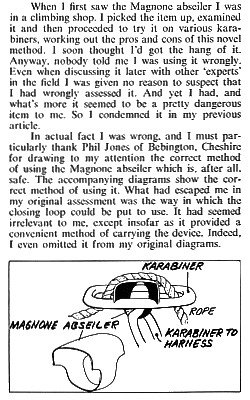Technical Details
I remember that caver giving me this device, probably at the 1982 Old Timers Reunion. Unfortunately, I did not record the details at the time. I acquired a second one from Bette Gledhill in 2022, and gave it to Stéphane Pennequin as a thank-you gift for items that he has sent to me in the past.
My Guido Magnone is 41 mm. tall, 45 mm. wide, 48 mm. thick, and weighs 56 g. The device is made out of 1.5 mm. stainless steel sheet
metal, cut and bent to shape, and secured with three spot welds.
The Magnone is stamped "G.Magnone."
 I first remember reading about the Magnone in Tomaz Planina’s 1976 article (Obraba vrvi
pri spuscanju z vrvnimi zavorami, Nase jame, 17, 1976,
pp. 15-22; "Climbing ropes wearing out with rope brakes,"
Nase jame, 19, 1977, pp. 15-22), which referred to it as the "tinp rope brake."
I first remember reading about the Magnone in Tomaz Planina’s 1976 article (Obraba vrvi
pri spuscanju z vrvnimi zavorami, Nase jame, 17, 1976,
pp. 15-22; "Climbing ropes wearing out with rope brakes,"
Nase jame, 19, 1977, pp. 15-22), which referred to it as the "tinp rope brake."
Originally, I wrote the following about the origin of this
device:
All I know about the origin of this device is that it is Italian.
"G. MAGNONE" is stamped into the back of the tinplate,
perhaps this refers to the manufacturer.
My information that the device was Italian came from page 19
of Planina’s 1977 article. In July 2006, Lorenzo Dotti of Milan,
Italy sent me the following additional information:
The descender "G. Magnone"
was most probably not made in Italy: Guido Magnone - in spite
of his Italian name - was a great French climber of the 70s,
and he should be the designer of this gear.
The Magnone fits over a standard oval or locking D carabiner, and is secured with a second carabiner. In use, it acts like a large brake bar. In March 2012, Stéphane Pennequin sent me an interesting article from the February/March issue of Rocksport. In the article, Derek Ellis described the proper use of the Magnone descender. After reading the article, I sent the following reply:
Derek Ellis’ Rocksport article is interesting, but to use the Magnone this way scares me. The weld holding it together is just a spot weld, and I would not trust it to hold my weight. I would almost expect it to break and then the descender would unwind, ruining my day!
Despite Ellis’ article and regardless of the original design intent, I feel that the user should clip into the first carabiner, and use the device
like a normal carabiner
brake bar rig. Spot welds can be strong, but I just don't trust my life to the ones on my Magnone. I am hesitant to show the excerpt from Ellis’ article, but not having seen another Magnone descender for many decades, I decided to include an image here for academic interest.
Stéphane told me that the the Magnone was introduced in 1969. He first saw it in Glace Neige et Roc by Gaston Rébuffat (1970). Not having that book, I ordered the English translation "On Ice and Snow and Rock" (1971). I immediately recognized the book and the pictures in it, but had forgotten the Magnone, which was shown on page 50. On the following page, Rébuffat wrote, "The Magnone descendeur consists of a small metal component… which can be inserted into any standard size snap link and acts as a brake on the abseiling rope; a second snap-link on the opposite side prevents the descendeur from jumping out…." Apparently Rébuffat and I agree that one does not clip into the Magnone the way Ellis reported in Rocksport.
In 1971, Charlet Moser took over the design and modified it heavily to form the Charler-Moser descender.
|
 |
Warning:
Do not clip to the securing carabiner because then the three spot welds will be all that support your weight. |
 |
|



